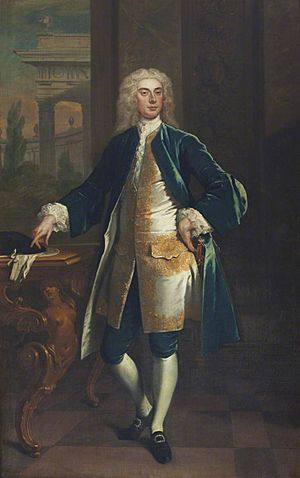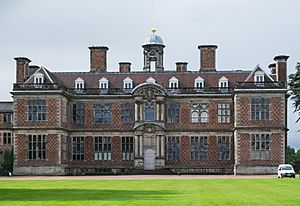George Venables-Vernon, 1st Baron Vernon facts for kids
Quick facts for kids
George Venables-Vernon
|
|
|---|---|
 |
|
| Member of the British Parliament for Lichfield |
|
| In office 1731–1747 |
|
| Member of the British Parliament for Derby |
|
| In office 1754–1762 |
|
| Lord Vernon, Baron of Kinderton | |
| In office 1762–1780 |
|
| Personal details | |
| Born | 9 February 1709 |
| Died | 2 August 1780 |
| Spouses |
|
George Venables-Vernon (born 9 February 1709, died 2 August 1780) was an important British politician. He served in the British Parliament for many years. Later, he was given a special title and became known as Lord Vernon.
Contents
Who Was George Venables-Vernon?
George Venables-Vernon was born into a well-known family. His father was Henry Vernon, who owned a large estate called Sudbury Hall in Sudbury, Derbyshire. George's mother was Anne, who inherited land from her family, the Pigotts and Venables.
Early Life and Family History
When George was young, his father passed away in 1719. This meant George inherited Sudbury Hall. In 1715, he also inherited land in Kinderton, Cheshire, from Sir Peter Venables. Because of this, in 1728, he officially added "Venables" to his last name. This is why he became George Venables-Vernon.
A Career in Politics
George Venables-Vernon was very active in British politics. He was elected as a Member of Parliament, which means he represented people in the government.
Representing Lichfield and Derby
He first served as a Member of Parliament for Lichfield. He held this position from 1731 to 1747. After a break, he was elected again, this time for Derby. He represented Derby from 1754 to 1762.
Becoming Lord Vernon
In 1762, George Venables-Vernon received a special honor. He was made a "peer," which is a high rank in British society. He was given the title Lord Vernon, Baron of Kinderton. This meant he became a member of the House of Lords, part of the British Parliament.
Sudbury Hall: His Home
Lord Vernon lived at Sudbury Hall. This house is considered one of the most beautiful mansions from the Restoration period in England. Today, Sudbury Hall is a Grade I listed building. This means it's a very important historical building that is protected.
Lord Vernon's Family Life
Lord Vernon was married three times during his life. Many of his children and grandchildren became famous in their own right.
First Marriage
In 1733, he married his first wife, Mary Howard. She was the daughter of Thomas Howard, the 6th Baron Howard of Effingham. They had one son together:
- George Venables-Vernon, 2nd Baron Vernon
Mary passed away in 1740.
Second Marriage
In 1741, Lord Vernon married Ann Lee. She was the daughter of Sir Thomas Lee. Sadly, Ann died the very next year.
Third Marriage
In 1744, he married his third wife, Martha Harcourt. She was the daughter of Simon Harcourt. Lord Vernon and Martha had one son:
Later Life and Legacy
Lord Vernon passed away in August 1780 when he was 71 years old. His son from his first marriage, George, inherited his title and became the 2nd Baron Vernon.
His second son from his third marriage, Edward Harcourt, became a very important religious leader. He was the Archbishop of York. Edward's grandson was Sir William Vernon Harcourt, a well-known politician. His great-grandson was Lewis Harcourt, 1st Viscount Harcourt.
After Lord Vernon died, his wife Martha, Lady Vernon, moved to Grosvenor Square. She lived there until she passed away in 1794.


